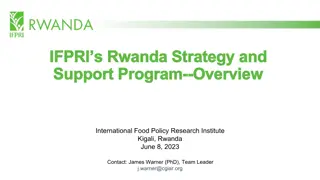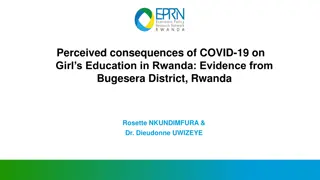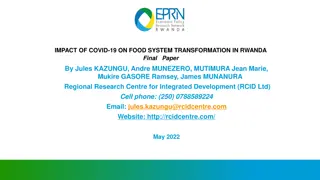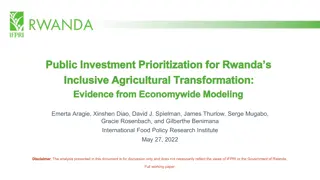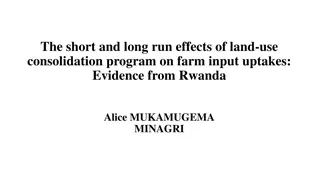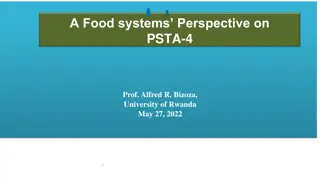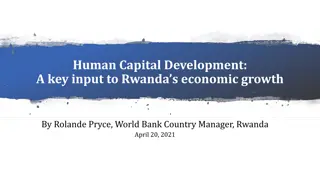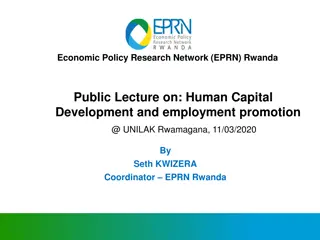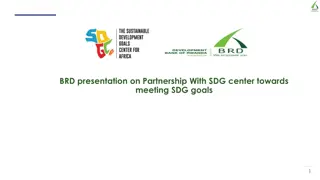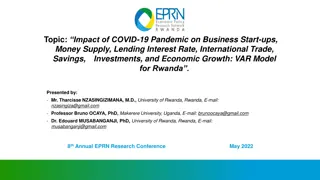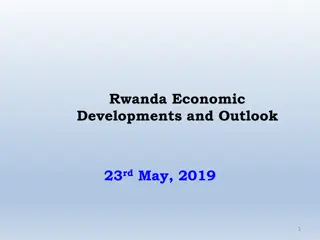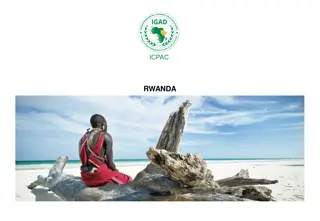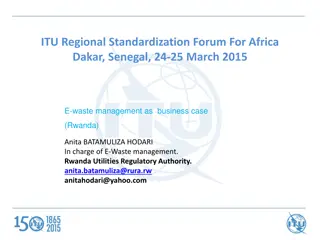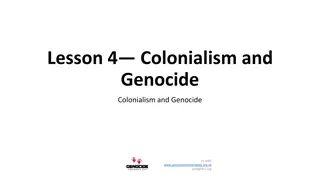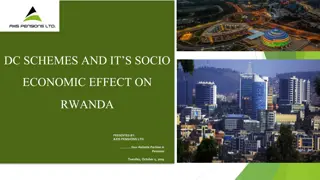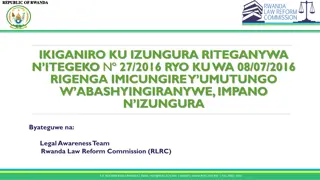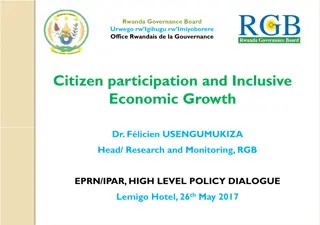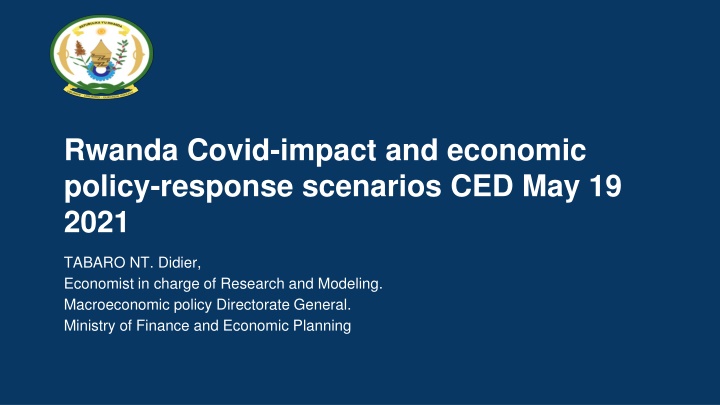
Economic Impact of Covid-19 in Rwanda
Assessing the economic impact of Covid-19 in Rwanda and analyzing the policy responses to mitigate the shocks. Explore scenarios, sectoral impacts, and outlook for recovery. Consider external demand, private foreign savings, and more.
Download Presentation

Please find below an Image/Link to download the presentation.
The content on the website is provided AS IS for your information and personal use only. It may not be sold, licensed, or shared on other websites without obtaining consent from the author. If you encounter any issues during the download, it is possible that the publisher has removed the file from their server.
You are allowed to download the files provided on this website for personal or commercial use, subject to the condition that they are used lawfully. All files are the property of their respective owners.
The content on the website is provided AS IS for your information and personal use only. It may not be sold, licensed, or shared on other websites without obtaining consent from the author.
E N D
Presentation Transcript
Rwanda Covid-impact and economic policy-response scenarios CED May 19 2021 TABARO NT. Didier, Economist in charge of Research and Modeling. Macroeconomic policy Directorate General. Ministry of Finance and Economic Planning
Outline Assessing Covid shock and economic impact Assessing Economic Policy Response and economic impact Formulation Economic Response Economic Policy Response Scenario Outcome 2020 and Outlook for Recovery, 2021-25 Appraising Projection versus outcome 2020 Updated May 2021 policy response scenario, 2021-25 Suggestions for future economic crisis-response preparedness
Introduction Describing MINECOFIN-CED s (external/domestic, supply/demand), policy responses, and impact of both on economy (sectors and accounts) and MT recovery path. approach to assessing Covid shocks Analysis in comparison with Nov. 2019 Baseline: projected growth path driven by public investment infrastructure, human capital, agricultural. productivity, and developments in key sectors. Assessing Covid-Shock and Policy-Response scenarios with help of CED intMF: a comprehensive model linking detailed economic accounts: real sectoral supply/demand (NA), and external, fiscal, monetary accounts; enabling analysis of government and private Savings-Investment balances.
Assessing Covid shock: external demand Estimates for sectoral shocks made early in lockdown (weeks 10-21) had dramatic drops in the sectors, representing three quarters of exports. For example, mineral exports, volume drops (by 50%) compounded by world price declines (by 19%), resulting in a 59% drop in $ value vis- -vis BL, amounting to 0.7% of BL GDP in 2020. Demand Exports G&S: in order of importance, tourism/MICE; non-trad. exports, trad. exports (mining, coffee), travel: total export demand drop by -/-9% of BL GDP. Only partial recovery in 2021-22, remain below their BL levels. Demand-Imports G&S: positive shock from drop in oil price (-/-36%) and domestic demand for foreign travel in equal parts, totaling -/-2% of BL GDP; Net external demand drop by equivalent of -/-6.8% of BL GDP in 2020.
Assessing Covid shock: private foreign savings Drop in remittances, private non-budgetary transfers, FDI, other net private capital Total shock close 4% of BL GDP, expected to slow down private investment Government foreign borrowing per se not affected by Covid. Shocks projected to continue 2021-22, but smaller
Assessing Covid shock: domestic dupply RCIEA in percentage change compared with the same week the previous year Estimates for sector shocks due to 11-week lockdown starting March 2020 were based on direct sector information and weekly indicators on CIEA and turnover (EBM sales) Total Turnovers
Assessing Covid shock: domestic supply Q1 had already slowdown: heavy rains and early impact of Covid on world economy: Q1: -4% vis- -vis BL Sector GDPs assessed based on constraints from lockdown and/or lack of foreign demand assessed for each sector (no additional intermediate demand effects) Supply GDP Q2: 10-95% activity drops , total supply shock in Q2: -21% vis-a-vis BL Supply GDP 2020: speed of normalization for Q3-Q4 assumed for each sector, amounting on average to Q3: -10% and Q4: 0% vis- -vis BL Ranked by absolute GDP impact: Hotels & Restaurants, professional/sports/real estate, trade, transport, mining, manufacturing: total impact 2020: -/-8.6% of BL GDP Only partial recovery in supply in 2021-22
Assessing Covid shock: domestic demand Shock to exports G&S assessed at -/-13% of BL GDP, No shock to real government demand and private consumption Optimism on private sector resilience, its access to credit facilities: no drop projected for real private investment despite expected drop in FDI and other private inflows Total shock demand side similar to shock supply side 2020: -9.5% of BL GDP Only partial recovery in supply in 2021-22 Comparison of supply-side and demand-side shocks to ensure consistency
Covid shock scenario: economic impact Real GDP -/-2% (or -/-8.6% vis-a-vis BL) from H&R and travel, trade, other services, mining, more than manufacturing; services hardest hit (and thus employment)
Covid shock scenario: economic impact Large worsening in Resource Balance: a 40% drop in exports G&S in US$ (vis- -vis 2019) only partly offset by a 20% drop in imports of G&S in US$ This reflects the keeping up of domestic demand (real government consumption and investment grow as in BL, an optimistic projection for private investment, and private consumption), such that the drop in GDP is largely matched by drop in RB
Covid shock scenario: economic impact Government deficit ratio (excl. grants) increases by over 2.5%. of GDP vis- -vis BL due to revenue losses (down-cycle) and lower nominal GDP, before response measures. In the absence of foreign financing (not yet mobilized), the financing gap (2% of GDP) would need to be do domestically financed, worsening the private sector S-I situation
Covid shock scenario: economic impact Current Account worsens beyond the RB due to the projected 50% drop in private non- budgetary transfers (steeper for remittances), in total by 3 %. of GDP. Expected drop in net private inflows (incl. FDI) combined with the government financing gap (domestic borrowing) generates a large BoP deficit and drop in NFA. It implies a large worsening of the S-I balance: reflecting government deficit and private sector widening excess of investment over domestic savings.
Assessing Economic Policy Response Fiscal response/impulse as of October 2020 PCI-3 review, Budget 2020/21 change in deficit (excl. grants) compared to BL though fiscal measures for 2019/20 programmed during Q2 2020 and several further measures added for 2020/21 since Oct 2020 Fiscal policy response measures 2019-2021 included: o health measures (medicine, PPEs, quarantine centers, ) o education (additional classrooms, teacher salaries, ) o support vulnerable households (VUP, public works, farm inputs, food/cash distr., ) o subsidies vulnerable enterprises (hotels & restaurants, transport sector, ) o subsidized loans for enterprises (incl. through economic Recovery Fund, ERF) economic stimulus: o side effect of mitigation: maintain demand, public investment (public works) pm Monetary and financial response measures: expansionary
Assessing Fiscal Impulse (Oct. 2020) Fiscal impulse assessed at average 2.5% of BL GDP p.y. for 3 years spending peak 2020/21: time needed to implement measures (esp. ERF) Increases since then (for 2020/21): fiscal impulse averages 3% p.y. for 3 years Covid-related deficit 4% of BL GDP, in part offset by lower capital spending Covid spending about half net lending, one quarter current, one quarter capital Covid current/capital spending: health, almost education, 1/3 hhold support Financing: foreign grants (+0.7% of BL GDP) and borrowing 2.3% of BL GDP, (more in 2019/20 4.3% of GDP, negative domestic financing for later use)
Fiscal Impulse: expected impact on GDP Stimulus effect of fiscal response expected to be small: high import component of health spending preventing losses/bankruptcy/borrowing by enterprises, Fiscal response and monetary expansion initially estimated to generate GDP growth of +2% in 2020 (instead of -2% without fiscal response) But lockdown effect in Q2 turned out more severe and longer, implying more protracted recovery in Q3-Q4, GDP projection revised down in October 2020 Offsetting effects: growth effect of fiscal impulse more severe Covid effect, this is reflected in the scenario result
Policy response scenario: economic impact GDP growth in 2020 projected at -/-0.2% vis- -vis 2019 (-/-7% vis- -vis BL 2020) In services: largest absolute GDP drop, but less severe in H&R and trade, more severe in other services than in initial Covid-Shock scenario Mining: less severe drop than initially projected, still considerable (but <1.5% of GDP)
Economic impact: real GDP and demand Aggregate demand is kept up as in Covid-shock scenario, esp. real government private demand seems more realistic: real private investment is lower (-/-5%) and real private consumption higher (+4%) Drop in Resource Balance: 14% drop in real exports of G&S (-/-21% cpd to BL) and 1% drop in imports G&S (-/-4% cpd to BL) combine to worsening similar to Covid-shock
Economic impact: government accounts Government deficit ratio (excl. grants) goes up by 2.5-4% of GDP in 2019/20 and 2020/21 (a bit less in BL GDP) Only a bit higher than Covid-shock scenario as part of new Covid spending is offset by other spending reduction, notably investment The higher deficits (vis-a-vis BL) are now more than fully foreign-financed (mostly loans)
Economic impact: external accounts Current Account worsens by 2 %. of GDP each year for 3 years Worsens less than Resource Balance as mobilized budget grants and debt service relief more than offset the now less serious shortfall in private transfers Drop in private capital inflows (incl. FDI) by almost 2% of GDP more pessimistic than initially (postponement of FDI and public enterprise loans) Capital account relieved by govt borrowing, drawdown on NFA avoided at least in 2020
Economic impact: savings-investment balances Current Account (excl. grants) worsens by 3.5%. of GDP each year for three years Higher government deficit (excl. grants) accounts for most of this (3.0%. of GDP p.y.) Private S-I balance (incl. remittances) accounts for remainder (0.5%. of GDP p.y.)
Outcome 2020 and Outlook for recovery 2021-25 Updated medium-term projections start from outcome 2020 (NISR NA) Macro projections under Covid done in March and later in 2020 proved fairly accurate on: GDP growth, sector composition, real demand growth, and fiscal and external accounts GDP growth: -3.4% in 2020, compared to projected -2% in March, and -0.2% in Oct 2020
Outlook for recovery 2021-25 (May 2021 policy response) Enhanced policy response and structural measures to limit Covid damage should allow return to pre-Covid growth: 6-7% growth in 2021-22, then back to 8% growth from 2023 With growth losses in 2020-22, even with fast recovery, the level of GDP still 11-14% below Baseline level in 2025, in the absence of stronger catch-up effects
Outlook for 2021-25: assessment of Covid harm The fast return to pre-Covid growth is based on following assessment of growth factors: no change in labor force participation little impact on skills/education, as losses in school year completion to be offset private investment incl. FDI to return to pre-Covid levels with good policies stepped-up public investment in infrastructure, digitalization, other reforms (TFP growth) productivity-enhancing adaptations in post-Covid area (work-from-home, digitalization) Overall: cautiously optimistic projection, with a downside-risk scenario on the side
Suggestions for future economic crisis-response preparedness External financing contingency mechanisms, esp. for private sector (i) larger contingency external financing for the government to address persistent large shocks, as LIDC rely on external financial firepower and cannot tap domestic savings (ii) contingency private external financing to maintain investment and allow a rapid return to the pre-crisis growth path More systematic social support and economic stimulus (iii) strengthening formal sector and creating novel informal sector social protection mechanisms (iv) planning more public programs that can be quickly triggered as stimulus measures Economic impact analysis and tools (v) deepen quantitative policy analysis to assess shocks and policy responses, business cycle model, and a range of down-side risk scenarios (vi) develop tools for analyzing employment/income distribution impact of shocks and policy responses (e.g., SAM/CGE model)
Annex. Fiscal policy response May 2021 (PCI-4) Covid spending further increased by 1% of GDP for 2020/21, esp. higher capital spending for education (fiscal impulse about the same as in Oct. 2020)

